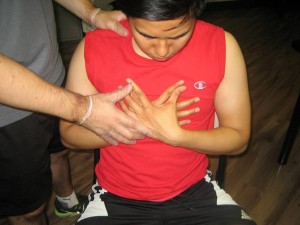Farmer’s lung is a disease due to chronic inhalation of biologic dust from hay or mold spores and agricultural products. Generally, people working with hay are susceptible to this condition.
Chronic exposure to this moldy hay, symptoms of respiratory illness starts to be felt. Furthermore, it causes in a type 111 hypersensitivity inflammatory reactions and can become a dangerous condition or called alveolitis. It results to severe coughing, fever and sometimes severe permanent physical damage.
People working with farm animals with hair, feathers and fur; agricultural chemicals; crop fields; fish meal; silage or grain storage silos and grains such as corn, hay and wheat are susceptible to this condition.
Causes
- Droppings of birds
- Bark of trees
- Dried urine of rats
- Animal dander
- Fungi
- Feathers
- Wood
- Insects

Symptoms develop within four to eight hour after exposure to the allergens. - Husks
Symptoms of farmer’s lung
- At first, shortness of breath occurs
- Fast heart beat
- Fast breathing
- Irritating cough
- Fever and chills
- Muscle pains
- In addition, sputum with blood
- Runny nose
- Crackling of breath
- Tightness of the chest
- Lastly, depression
Symptoms develop within four to eight hour after exposure to the allergens. It has the similarities with pneumonia or flu and sometimes the affected person will be shocked and eventually die.
Treatment
- Rest plenty of bed rest. Avoid performing strenuous activities while in the healing stage.
- Take prescribed corticosteroids to lessen the symptoms and the pain.
- Use oxygen therapy for acute attacks. This therapy is also called supplemental oxygen as medical treatment such as low blood oxygen and carbon monoxide toxicity. Oxygen is given in ways that includes face mask, nasal cannula and inside a hyperbaric chamber.
- Avoid exposure to the mold or dusty environment for at least a few months for fast healing of the condition.
- Stay in places away from dusty and moldy environment while still healing. Generally, stay in rooms with good ventilation, if possible in airconditioned rooms to prevent dust and molds from entering the room.
Tips
- When working in farms wear protective gear such as face mask or respirators to prevent inhaling spores of mold to prevent development of infections.
- When returning to work, if possible implement some preventive techniques or ways of preventing mold from contaminating agricultural environment which include complete drying of crops before storage; wetting grain or feed before moving them to prevent excessive release of dust particle and use of mold inhibitors which prevents crops from developing molds.
- Provide adequate ventilation when working especially in confined areas. Proper ventilation in stables or hay barn, and keep windows and doors open to keep flow of air clean and clear. Install extractor or a fan to remove dust particles present in air and prevent infected by farmer’s lung.
- Work outside if possible to lessen the symptoms of farmer’s lung and prevent infected by the condition. In addition, work outside even if it is cold.
FACT CHECK
https://www.webmd.com/lung/farmers-lung-facts#1
